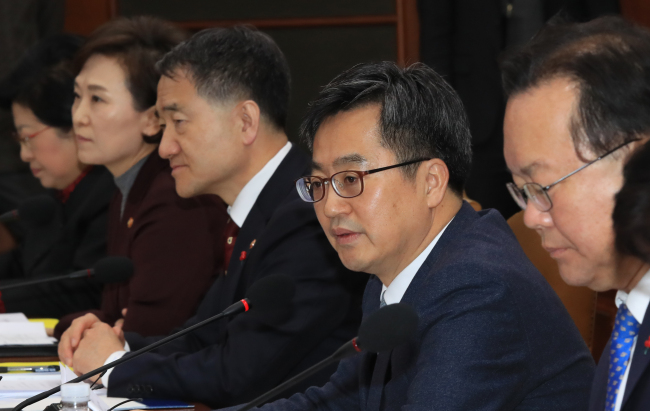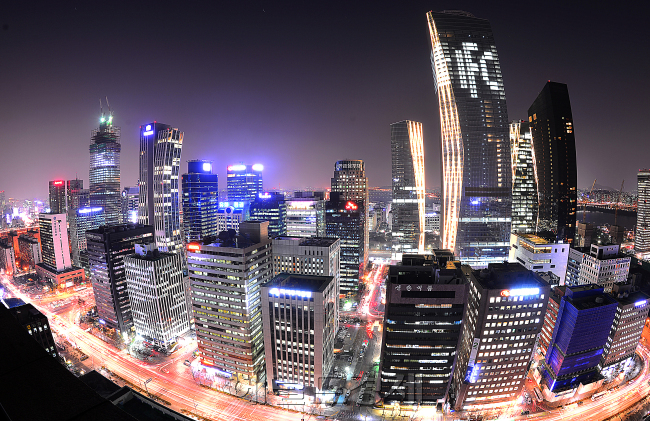Korea unveils plans to prop up second-tier stock bourse
KRX to release new composite stock market indexes, tax relief, funds to prop up Kosdaq
By Son Ji-hyoungPublished : Jan. 11, 2018 - 14:50
South Korea unveiled Wednesday plans to prop up the tech-heavy Kosdaq bourse by giving tax relief to investors, creating new composite stock market indexes and lowering the entry barrier for firms to go public on the market.
The measures, released by the Financial Services Commission, aim to stimulate venture firms’ growth in line with the Moon Jae-in administration’s policy direction and the market itself suffering from the flight of powerhouses, such as Kakao and Celltrion, seeking to land on the top-tier Kospi market for larger investment opportunities.
Despite soaring financial market liquidity on the back of monetary expansion, entry into the second-tier market has remained subpar, posing hurdles to the growth of venture firms.
The measures, released by the Financial Services Commission, aim to stimulate venture firms’ growth in line with the Moon Jae-in administration’s policy direction and the market itself suffering from the flight of powerhouses, such as Kakao and Celltrion, seeking to land on the top-tier Kospi market for larger investment opportunities.
Despite soaring financial market liquidity on the back of monetary expansion, entry into the second-tier market has remained subpar, posing hurdles to the growth of venture firms.

“We will prop up innovative growth by activating the Kosdaq market,” said Deputy Prime Minister for Economy and Finance Minister Kim Dong-yeon during a meeting of economy-related ministers. “The Kosdaq market is the core infra that fosters venture companies, and it will be reinforced to become a sound and trusted market.”
On Thursday, the Kosdaq closed at the highest mark in nearly 16 years. The composite index jumped 2.1 percent to close at 852.51, on the back of institutional net purchases worth over 215 billion won ($200.7 million).
The plans by the FSC include giving tax breaks to individuals investing in mutual funds for startups, easing listing rules for the market and creating a fund of 300 billion won to invest in Kosdaq-listed firms.
Also, the Korea Exchange will introduce new indexes with stocks listed on both the first-tier Kospi and Kosdaq to woo institutional investors.
One of them is the provisionally named KRX 300, consisting of 300 firms -- 232 from Kospi and 68 from Kosdaq -- to be released from Feb. 5. By market cap, the Kosdaq will be responsible for 6.5 percent of the new index, explained Edward Lee, director-general of the index business department of the Korea Exchange.
The components will be selected from the top shares by market cap from nine categories following the guidance of the Global Industry Classification Standard.
There are currently two composite indexes for the Kospi and Kosdaq -- the KTOP30 and KRX100 -- which have been deemed insufficient to represent the Korean markets, containing little composition of Kosdaq-listed firms.
The KRX will also introduce another new index, by June, made up of small and mid-cap shares from both the Kospi and Kosdaq.
The government said it aims to diversify the money flow that has been concentrated toward the Kospi 200, tracked by 11 exchange traded funds, 23 exchange traded notes, as well as derivatives, which it said has failed to reflect the Kosdaq market and lacks in diversity.
The market cap of constituents for the Kospi 200, created in 1994, accounts for over 75 percent of the Kospi and the Kosdaq combined.
On Thursday, the Kosdaq closed at the highest mark in nearly 16 years. The composite index jumped 2.1 percent to close at 852.51, on the back of institutional net purchases worth over 215 billion won ($200.7 million).
The plans by the FSC include giving tax breaks to individuals investing in mutual funds for startups, easing listing rules for the market and creating a fund of 300 billion won to invest in Kosdaq-listed firms.
Also, the Korea Exchange will introduce new indexes with stocks listed on both the first-tier Kospi and Kosdaq to woo institutional investors.
One of them is the provisionally named KRX 300, consisting of 300 firms -- 232 from Kospi and 68 from Kosdaq -- to be released from Feb. 5. By market cap, the Kosdaq will be responsible for 6.5 percent of the new index, explained Edward Lee, director-general of the index business department of the Korea Exchange.
The components will be selected from the top shares by market cap from nine categories following the guidance of the Global Industry Classification Standard.
There are currently two composite indexes for the Kospi and Kosdaq -- the KTOP30 and KRX100 -- which have been deemed insufficient to represent the Korean markets, containing little composition of Kosdaq-listed firms.
The KRX will also introduce another new index, by June, made up of small and mid-cap shares from both the Kospi and Kosdaq.
The government said it aims to diversify the money flow that has been concentrated toward the Kospi 200, tracked by 11 exchange traded funds, 23 exchange traded notes, as well as derivatives, which it said has failed to reflect the Kosdaq market and lacks in diversity.
The market cap of constituents for the Kospi 200, created in 1994, accounts for over 75 percent of the Kospi and the Kosdaq combined.

Meanwhile, pension funds will get their securities transaction tax of 0.3 percent in Korea exempted when selling Kosdaq-listed shares, starting in the second half of 2018 following a law revision, while a retail investor can get a tax deduction of 10 percent on investments of up to 30 million won made up of Kosdaq shares, starting February.
“Institutional investors like pension fund managers tolerate risk and engage in a sustainable investment scheme, and their investment into Kosdaq shares is crucial,” said Park Jung-hoon, director-general of Capital Markets Bureau of the FSC.
As of September, Kosdaq shares accounted for a mere 2 percent in the stock portfolio of the largest local public fund, the National Pension Service, worth 125 trillion won.
To directly help prop up Kosdaq-listed firms, a fund of 300 billion won, the “Kosdaq scale-up Fund,” is to be created, with half of the investments coming from local financial institutions.
Also, to help along the initial public offering process for firms showing potential, some prerequisites will be scrapped within the first half of this year. They include evidence of continuous profitability and no cases of capital damage.
More firms that suffer low profitability despite growth potential will also be encouraged to take on an abridged IPO process through the new “Tesla Policy,” named for the Nasdaq-listed US electric vehicle maker. The policy was introduced in December 2016.
Through a “put-back option,” an underwriter is obliged to buy stocks from investors when the stock price of firms that went public falls below 90 percent of the initially offered price within three months.
Following the measure, however, an underwriter will be exempt from the put-back option if the underwriter has had no cases of the option within three years. Firms will also be exempted from the option if they have moved to the Kosdaq from the third-tier Konex market with records of over 1,000 shares traded daily on average over six months.
(consnow@heraldcorp.com)
“Institutional investors like pension fund managers tolerate risk and engage in a sustainable investment scheme, and their investment into Kosdaq shares is crucial,” said Park Jung-hoon, director-general of Capital Markets Bureau of the FSC.
As of September, Kosdaq shares accounted for a mere 2 percent in the stock portfolio of the largest local public fund, the National Pension Service, worth 125 trillion won.
To directly help prop up Kosdaq-listed firms, a fund of 300 billion won, the “Kosdaq scale-up Fund,” is to be created, with half of the investments coming from local financial institutions.
Also, to help along the initial public offering process for firms showing potential, some prerequisites will be scrapped within the first half of this year. They include evidence of continuous profitability and no cases of capital damage.
More firms that suffer low profitability despite growth potential will also be encouraged to take on an abridged IPO process through the new “Tesla Policy,” named for the Nasdaq-listed US electric vehicle maker. The policy was introduced in December 2016.
Through a “put-back option,” an underwriter is obliged to buy stocks from investors when the stock price of firms that went public falls below 90 percent of the initially offered price within three months.
Following the measure, however, an underwriter will be exempt from the put-back option if the underwriter has had no cases of the option within three years. Firms will also be exempted from the option if they have moved to the Kosdaq from the third-tier Konex market with records of over 1,000 shares traded daily on average over six months.
(consnow@heraldcorp.com)










![[Today’s K-pop] BTS pop-up event to come to Seoul](http://res.heraldm.com/phpwas/restmb_idxmake.php?idx=644&simg=/content/image/2024/04/17/20240417050734_0.jpg&u=)
![[Graphic News] More Koreans say they plan long-distance trips this year](http://res.heraldm.com/phpwas/restmb_idxmake.php?idx=644&simg=/content/image/2024/04/17/20240417050828_0.gif&u=)





![[KH Explains] Hyundai's full hybrid edge to pay off amid slow transition to pure EVs](http://res.heraldm.com/phpwas/restmb_idxmake.php?idx=652&simg=/content/image/2024/04/18/20240418050645_0.jpg&u=20240419100350)

